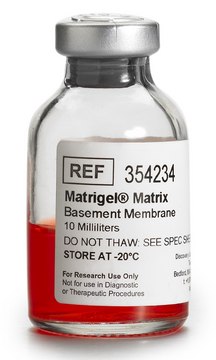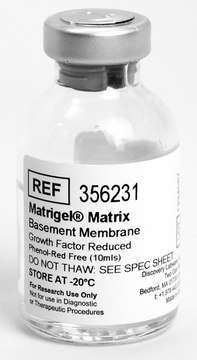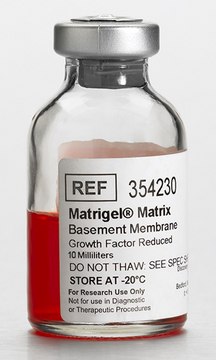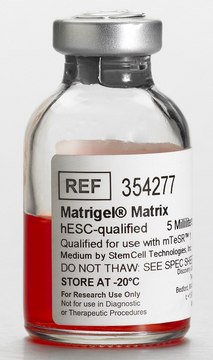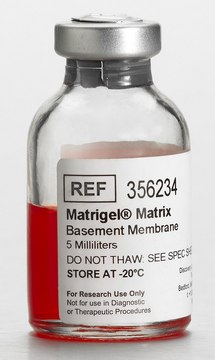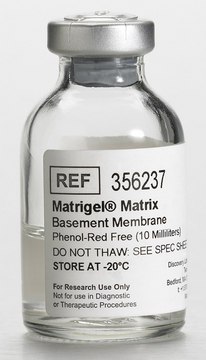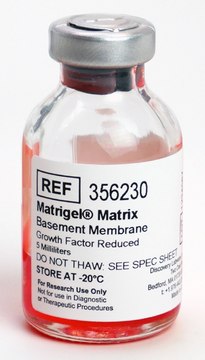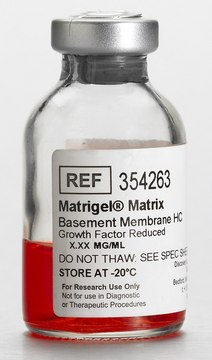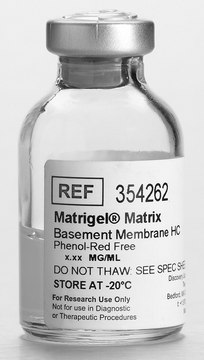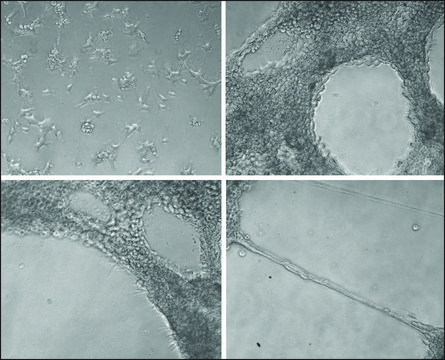DLW356231
Corning® Matrigel® Matrigel Matrix GFR PhenolRF Mouse 10 mL
Sign Into View Organizational & Contract Pricing
All Photos(1)
About This Item
UNSPSC Code:
12352207
Recommended Products
shipped in
dry ice
storage temp.
−20°C
General description
Corning Matrigel matrix is a solubilized basement membrane preparation extracted from the Engelbreth-Holm-Swarm (EHS) mouse sarcoma, a tumor rich in extracellular matrix proteins, including Laminin (a major component), Collagen IV, heparin sulfate proteoglycans, entactin/nidogen, and a number of growth factors.
Quality
Quality
- Mouse colonies routinely screened for pathogens via Mouse Antibody Production (MAP) testing.
- Extensive PCR testing is performed to screen for a number of pathogens.
- Tested and found negative for bacteria, fungi, and mycoplasma.
- Protein concentrations determined by Lowry method.
- Endotoxin units measured by Limulus Amoebocyte Lysate assay.
- Matrigel Matrix gel stability is tested for a period of 14 days at 37°C.
- Biological activity is determined for each lot using a neurite outgrowth assay.
Other Notes
Source:
Engelbreth-Holm-Swarm Mouse Tumor.
Formulation:
High concentration laminin/entactin complex frozen in Dulbecco′s PBS.
Engelbreth-Holm-Swarm Mouse Tumor.
Formulation:
High concentration laminin/entactin complex frozen in Dulbecco′s PBS.
Legal Information
Corning is a registered trademark of Corning, Inc.
Matrigel is a registered trademark of Corning, Inc.
Storage Class Code
13 - Non Combustible Solids
WGK
WGK 3
Flash Point(F)
Not applicable
Flash Point(C)
Not applicable
Regulatory Information
新产品
Choose from one of the most recent versions:
Certificates of Analysis (COA)
Lot/Batch Number
Sorry, we don't have COAs for this product available online at this time.
If you need assistance, please contact Customer Support.
Already Own This Product?
Find documentation for the products that you have recently purchased in the Document Library.
Muhammedin Deliorman et al.
Bio-protocol, 10(18), e3764-e3764 (2021-03-05)
This protocol describes a simple method to cryopreserve mammalian cells within filter papers as an alternative to conventional slow-freezing approach. The method involves treating paper fibers with fibronectin, using low concentrations of the cryoprotectant dimethyl sulfoxide (DMSO), and slow freezing
Our team of scientists has experience in all areas of research including Life Science, Material Science, Chemical Synthesis, Chromatography, Analytical and many others.
Contact Technical Service